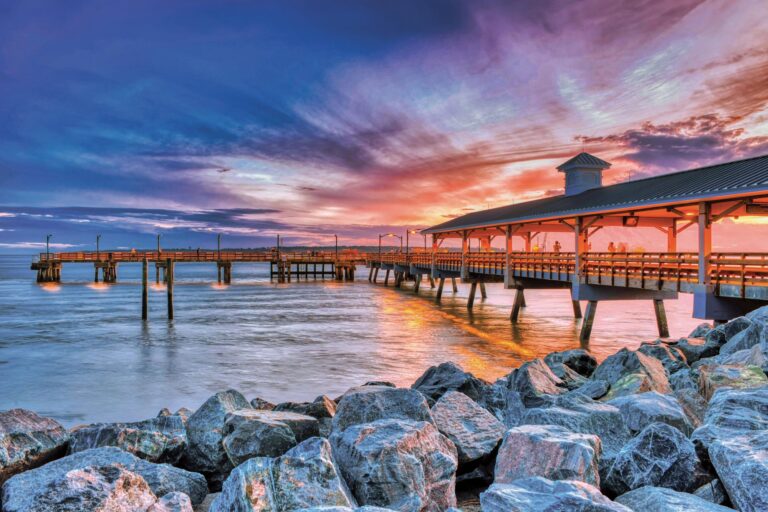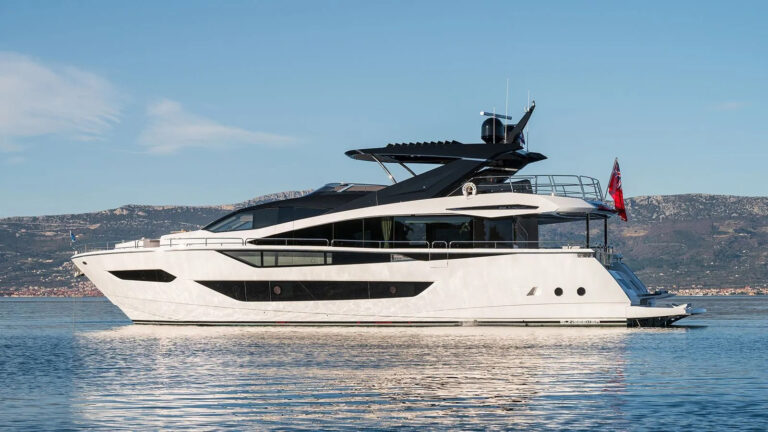When I met Peter and Everett Landeweer and their father in 1987, they had just arrived in South Florida with their 67-foot Dutch-built aluminum convertible Snow Goose. They had a passion for fishing and boatbuilding, and were capable players in both pursuits.
While campaigning Snow Goose on the tournament circuit, the Landeweers saw an opportunity for a builder of high-quality, fast, custom convertibles. They purchased Garlington Marine, a small builder in Stuart, Florida, that had earned a fine reputation building custom tournament boats. Unlike the majority of builders in this specialized market, Garlington had switched from cold-molded wood construction to molded fiberglass construction. Customers followed, and the Garlington Landeweer 61-footer, introduced in 1994, continues to be a success.
Interest in even larger convertibles was growing, and the family saw another opportunity. Garlington Landeweer’s facilities in Stuart had expanded, but so had its order book for 61s.
“We had customers that wanted the 80, and we didn’t have the space or enough craftsmen to build it,” Peter said.
Fate intervened when the Landeweers met the principles of McMullen & Wing, the New Zealand yard that built the 1995 America’s Cup winner Black Magic. A visit to the yard followed, an agreement was penned, and tooling and the first boat were completed in a lightning-quick 15 months.
“In my opinion,” Peter said, “New Zealanders are number one in composite construction.”
I caught up with hull number two in Ft. Lauderdale. The only thing more spectacular than the Garlington Landeweer 80 resting dockside is the vision of her hurtling through the sea at more than 30 knots. The 80 is spot on from every angle. Her long, sweeping sheer caps a hull with appropriate flare at the bow and a tasteful amount of tumblehome at the transom. Her rakish house is perfectly proportioned, leaving a long, clean foredeck and enough cockpit area for a square dance.
Hull number two has an enclosed bridge, an aesthetic challenge on convertible designs but no compromise for the 80. An enclosed bridge makes sense for convertibles this size. While fish-boat purists may cringe at the thought, an 80-footer without an all-weather helm station is a compromise. This is particularly true for those who intend to cruise to remote fishing grounds.
The 80’s bridge has a helm forward arrangement with helm and companion seating. A lounge area is aft, and an interior stair leads below to the saloon. A door provides access to an exterior balcony that overlooks the cockpit and is outfitted with controls. While this position offers an excellent view of the action, serious anglers should consider a tower.
Massive teak covering boards surround the 250-square-foot teak-sole cockpit. The clean, uncluttered work space has a lazarette and fishbox. Bulkhead cabinetry includes a full tackle center with a sink, two freezers and a refrigerated drink box. A lower balcony four steps above the cockpit has bench seating with built-in rod stowage and a live well that is accessible from the cockpit.
The 80’s generous 21-foot, 6-inch beam benefits the interior accommodations. The open saloon arrangement is split-level with a seating area aft and a raised galley and dinette area forward. Crew accommodations are tucked beneath this raised area and are accessible from the accommodations space or the cockpit via the machinery space.
Owner and guest accommodations are forward of the crew’s quarters and include a master with a king-size berth and private head. The VIP stateroom is of equal proportion, and a third stateroom has upper and lower berths and private access to the day head. Hull number two’s satin-finished teak interior is simple in design, yet flawlessly executed.
Designer Michael Peters sculpted the 80’s hull, which is defined by relatively fine convex forward sections that meld into an 18-degree deadrise at the transom. A chine ledge and a series of strakes control spray forward. The Landeweers selected a V-drive engine orientation based on their experience with Snow Goose. This configuration makes sense for several reasons, but most important is that it keeps the engines-a major fixed weight-farther aft. This, in turn, keeps the center of gravity from migrating too far forward and compromising performance at high speeds. In addition, shaft angle and engine-mounting angles are minimized. Shallow propeller pockets that account for appropriate tip clearance complement the 80’s 8.5-degree shaft angle, creating a draft of only 5 feet, 9 inches.
For her size and outfitting, the 80’s 125,000-pound displacement (half-load) is relatively light compared with that of other boats in her class. This is a result of her carefully executed composite construction. Her bottom is a blend of multidirectional stitched reinforcements sandwiching a double 11/2-inch foam core. Her bottom is stiffened by a hearty fiberglass stringer system that is supported by foam-cored fiberglass bulkheads and web frames. Foam coring is also used in the hull sides, decks and superstructure. Lightweight honeycomb and foam coring are used in the nonstructural interior components, as well. Boatbuilding is a prestigious pursuit in New Zealand, and the skill and pride of the craftsmen who built the 80 are reflected in her structural detail.
The same level of detail and craftsmanship exist in the 80’s machinery installation and systems. Her engineroom is bathed in a mirror-like white finish, and there is standing headroom on centerline. Sea chests are molded integrally with the hull and supply raw water to the engines and auxiliary systems. Exhaust is discharged through Marine Exhaust Systems linear mufflers. The main engines and remotely mounted gearboxes rest on foundations fixed to aluminum channels, which are fastened atop the stringers. A pump room immediately forward of the engineroom houses various ship’s systems.
To call the 80 your own will require an investment of about $4.7 million. The price does not include electronics or a tower.
Contact: Garlington Landeweer, (561) 283-7124; fax (561) 220-1049.









